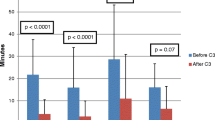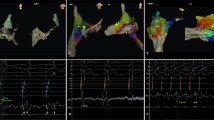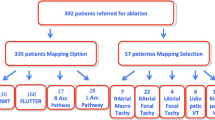Abstract
Purpose
Catheter ablation is the established curative therapy for pediatric tachyarrhythmias. However, exposure to ionizing radiation from fluoroscopy during the procedure is of concern to both patients and caregivers. We sought to assess the impact of an impedance-based three-dimensional navigation system (NavXTM, Endocardial Solutions, Inc., St. Paul, MN) on pediatric catheter ablation procedures.
Methods
We retrospectively analyzed procedural data during a 7-year period (2002–2008), which spanned the transition between standard fluoroscopic mapping and adoption of NavXTM mapping for catheter ablation of atrioventricular nodal reentrant tachycardia (AVNRT) and right/left-sided accessory pathways (RAP/LAP). Comparisons of total procedure time, total fluoroscopy time, and ablation fluoroscopy time (from insertion of ablation catheter until completion of procedure) between NavXTM and conventional mapping were made.
Results
Three hundred eighty-eight patients (aged 1–18 years, M/F 236:183) underwent ablation of AVNRT (n = 101), LAP (n = 130), or RAP (n = 157) using either conventional (n = 70) or NavXTM (n = 318) mapping. Overall success rates were similar between the two mapping approaches (95.7% for conventional versus 95.9% for NavXTM). NavXTM mapping significantly reduced ablation fluoroscopy time (15.9 ± 14.3 versus 11.0 ± 8.9 min for NavXTM, p < 0.01) with a trend towards a decrease in total fluoroscopy time (26.4 ± 15.6 versus 23.8 ± 11.1 min for NavXTM, p = 0.095). Total procedure time was not significantly different between the two methods (210.1 ± 66 versus 222.8 ± 61 min for NavXTM, p = 0.13). When analyzed by arrhythmia substrate, there were significant reductions in ablation fluoroscopy time for both LAP and RAP.
Conclusions
NavXTM mapping reduced ablation fluoroscopy times for accessory pathways during pediatric catheter ablation.

Similar content being viewed by others
References
Van Hare, G. F., Javitz, H., Carmelli, D., Saul, J. P., Tanel, R. E., Fischbach, P. S., et al. (2004). Prospective assessment after pediatric cardiac ablation: demographics, medical profiles, and initial outcomes. Journal of Cardiovascular Electrophysiology, 15(7), 759–770.
Lickfett, L., Mahesh, M., Vasamreddy, C., Bradley, D., Jayam, V., Eldadh, Z., et al. (2004). Radiation exposure during catheter ablation of atrial fibrillation. Circulation, 110(19), 3003–3010.
Rosenthal, L. S., Beck, T. J., Williams, J., Mahesh, M., Herman, M. G., Dinerman, J. L., et al. (1997). Acute radiation dermatitis following radiofrequency catheter ablation of atrioventricular nodal reentrant tachycardia. Pacing and Clinical Electrophysiology, 20(7), 1834–1839.
Nahass, G. T. (1995). Fluoroscopy and the skin: implications for radiofrequency catheter ablation. The American Journal of Cardiology, 76(3), 174–176.
Mahesh, M. (2001). Fluoroscopy: patient radiation exposure issues. Radiographics, 21(4), 1033–1045.
Calkins, H., Niklason, L., Sousa, J., el-Atassi, R., Langberg, J., & Morady, F. (1991). Radiation exposure during radiofrequency catheter ablation of accessory atrioventricular connections. Circulation, 84(6), 2376–2389.
Lindsay, B. D., Eichling, J. O., Ambos, H. D., & Cain, M. E. (1992). Radiation exposure to patients and medical personnel during radiofrequency catheter ablation for supraventricular tachycardia. The American Journal of Cardiology, 70(2), 218–233.
Kovoor, P., Ricciardello, M., Collins, L., Uther, J. B., & Ross, D. L. (1998). Risk to patients from radiation associated with radiofrequency ablation for supraventricular tachycardia. The American Journal of Cardiology, 98(15), 1534–1540.
Novak, P. G., Guerra, P. G., Thibault, B., & Macle, L. (2004). Utility of a nonfluoroscopic navigation system for pulmonary vein isolation. Journal of Cardiovascular Electrophysiology, 15(8), 967.
Van Hare, G. F., & McDaniel, G. M. (2006). Catheter ablation in children and adolescents. Heart Rhythm, 3(1), 95–101.
Schneider, M. A. E., Ndrepepa, G., Zrenner, B., Karch, M. R., Schmieder, S., Deisenhofer, I., et al. (2001). Noncontact mapping guided ablation of atrial flutter and enhanced-density mapping of the inferior vena cava-tricuspid annulus isthmus. Pacing and Clinical Electrophysiology, 24(12), 1755–1764.
Kottkamp, H., Hugl, B., Krauss, B., Wetzel, U., Fleck, A., Schuler, G., et al. (2000). Electromagnetic versus fluoroscopic mapping of the inferior isthmus for ablation of typical atrial flutter. A prospective randomized study. Circulation, 102(17), 2082–2086.
Willems, S., Weiss, C., Ventura, R., Ruppel, R., Risius, T., Hoffmann, M., et al. (2000). Catheterablation of atrial flutter guided by electroanatomic mapping (CARTO): a randomized comparison to the conventional approach. Journal of Cardiovascular Electrophysiology, 11(11), 1223–1230.
Nakagawa, H., & Jackman, W. M. (1998). Use of a three-dimensional, nonfluoroscopic mapping system for catheter ablation of typical atrial flutter. Pacing and Clinical Electrophysiology, 21(6), 1279–1286.
Schneider, M. A. E., Ndrepepa, G., Dobran, I., Schreieck, J., Weber, S., Plewan, A., et al. (2003). LocaLisa catheter navigation reduced fluoroscopy time and dosage in ablation of atrial flutter: a prospective randomized study. The Journal of Cardiovascular Electrophysiology, 14(6), 587–590.
Wittkampf, F. H., Wever, E. F., Vos, K., Geleijns, J., Schalij, M. J., Tol, J., et al. (2000). Reduction of radiation exposure in the cardiac electrophysiology laboratory. Pacing and Clinical Electrophysiology, 23(11), 1638–1644.
Kirchhof, P., Loh, P., Eckardt, L., Ribbing, M., Rolf, S., Eick, O., et al. (2002). A novel nonfluoroscopic catheter visualization system (LocaLisa) to reduce radiation exposure during catheter ablation of supraventricular tachycardias. The American Journal of Cardiology, 90(3), 340–343.
Danford, D. A., Kugler, J. D., Deal, B., Case, C., Friedman, R. A., Saul, J. P., et al. (1995). The learning curve for radiofrequency ablation of tachyarrhythmias in pediatric patients. The American Journal of Cardiology, 75(8), 587–590.
Papagiannis, J., Tsoutsinos, A., Kirvassilis, G., Sofianidou, I., Koussi, T., Laskari, C., et al. (2006). Nonfluoroscopic catheter navigation for radiofrequency catheter ablation of supraventricular tachycardia in children. Pacing and Clinical Electrophysiology, 29(9), 971–978.
Tuzcu, V. (2007). A nonfluoroscopic approach for electrophysiology and catheter ablation procedures using a three-dimensional navigation system. Pacing and Clinical Electrophysiology, 30(4), 519–525.
Smith, G., & Clark, J. M. (2007). Elimination of fluoroscopy use in a pediatric electrophysiology laboratory utilizing three-dimensional mapping. Pacing and Clinical Electrophysiology, 30(4), 510–518.
Clark, J., Bockoven, J. R., Lane, J., Patel, C. R., & Smith, G. (2008). Use of three-dimensional catheter guidance and trans-esophageal echocardiography to eliminate fluoroscopy in catheter ablation of left-sided accessory pathways. Pacing and Clinical Electrophysiology, 31(3), 283–289.
Author information
Authors and Affiliations
Corresponding author
Additional information
Andrea Neilson was at the Labatt Family Heart Centre during the initial data collection and analysis for this study.
Rights and permissions
About this article
Cite this article
Kwong, W., Neilson, A.L., Chiu, C.C. et al. The effect of NavX on fluoroscopy times in pediatric catheter ablation. J Interv Card Electrophysiol 33, 123–126 (2012). https://doi.org/10.1007/s10840-011-9604-y
Received:
Accepted:
Published:
Issue Date:
DOI: https://doi.org/10.1007/s10840-011-9604-y




